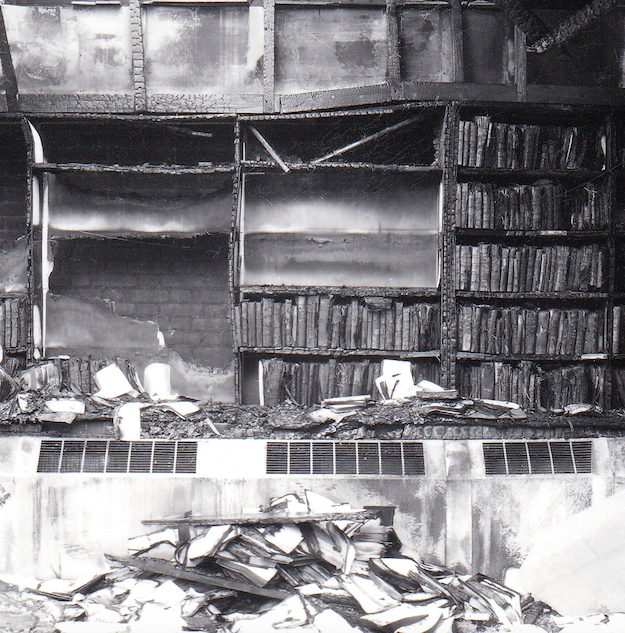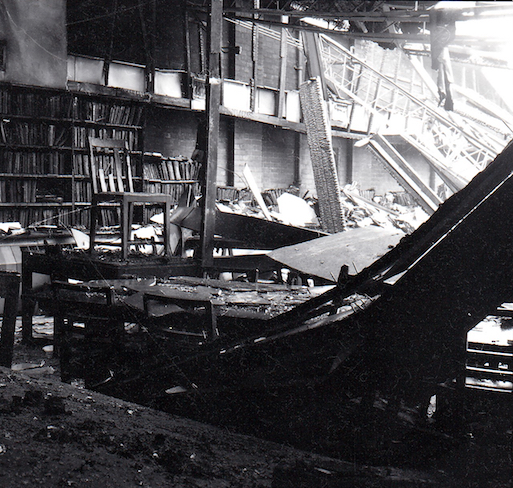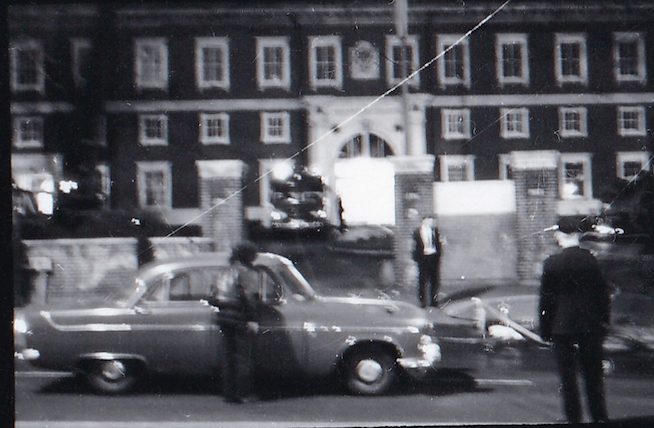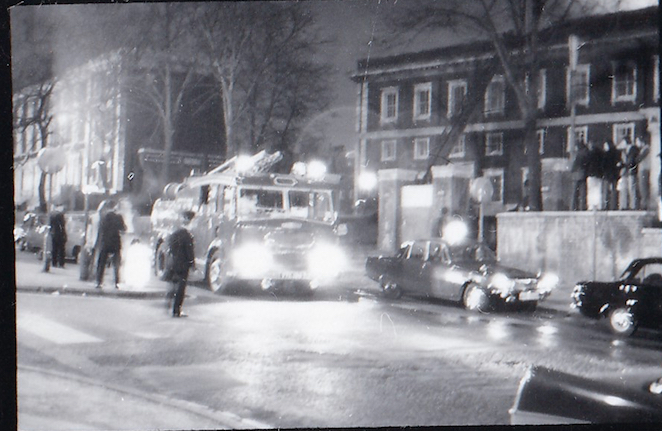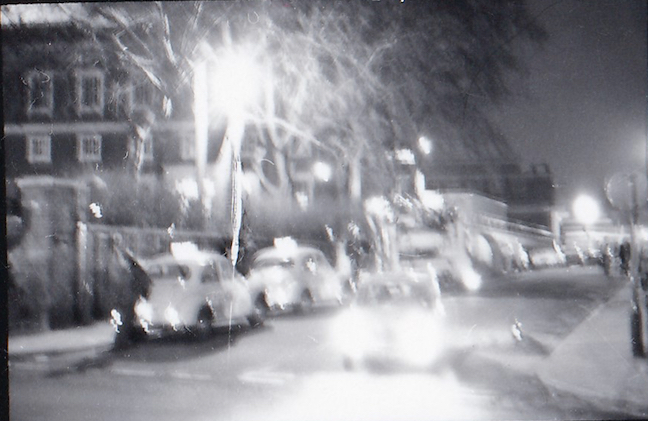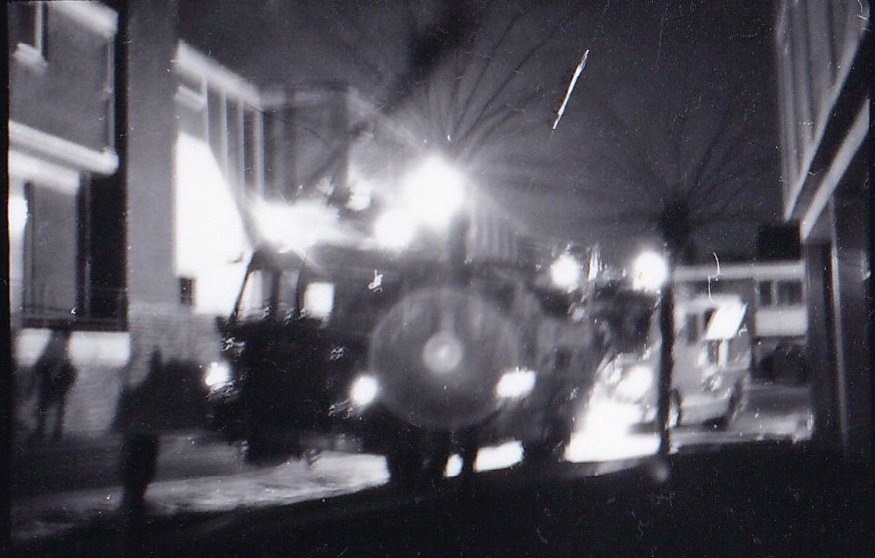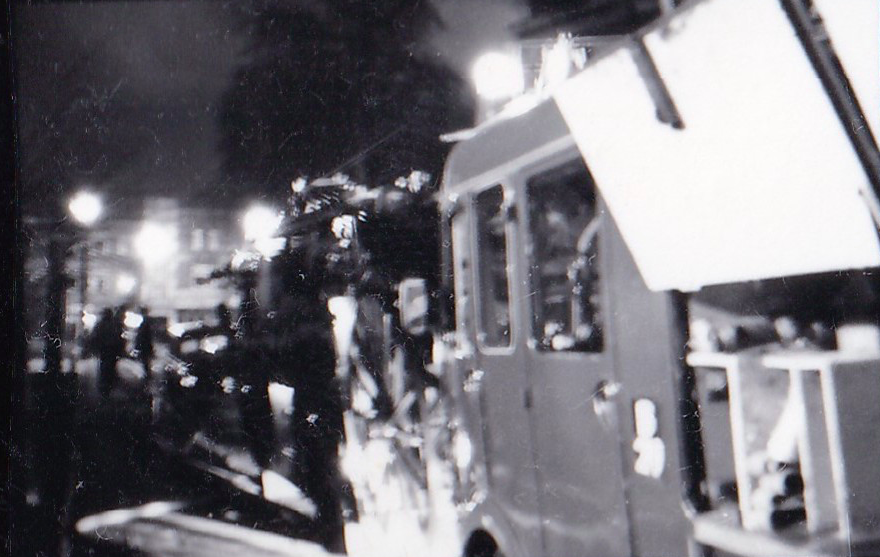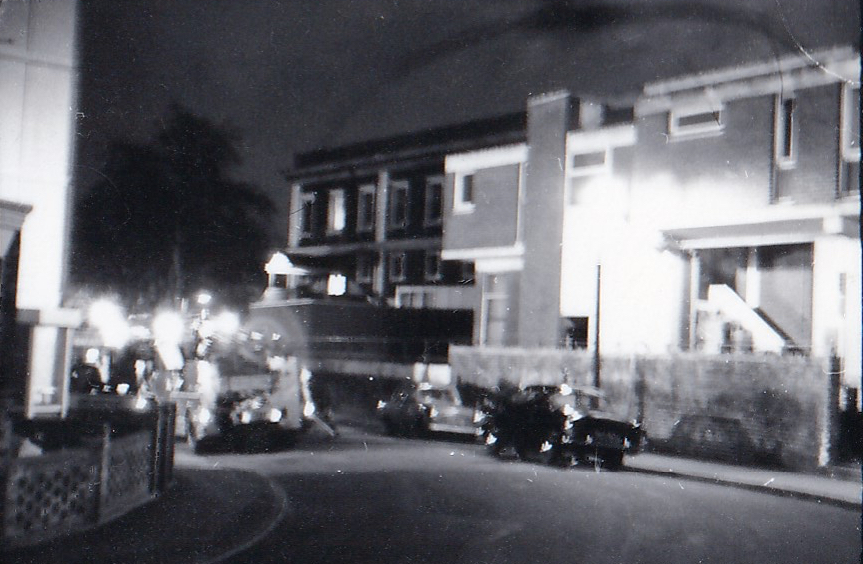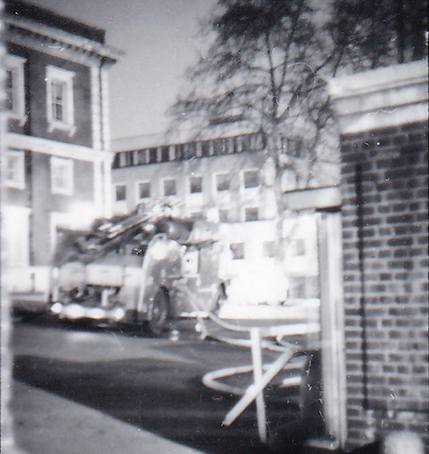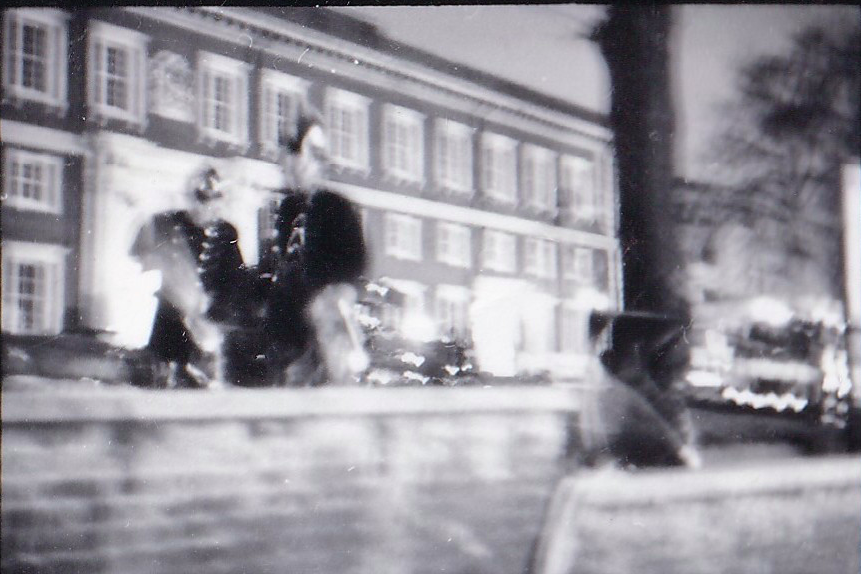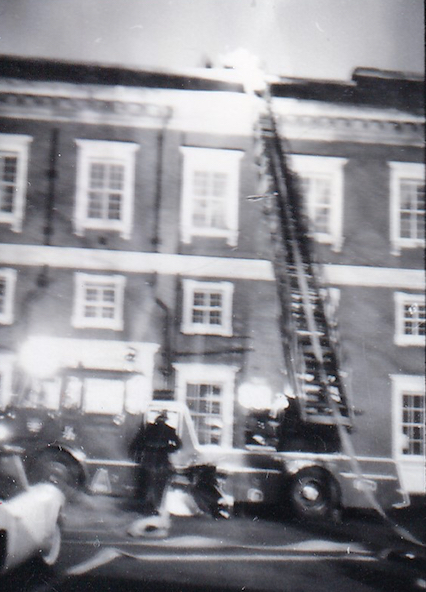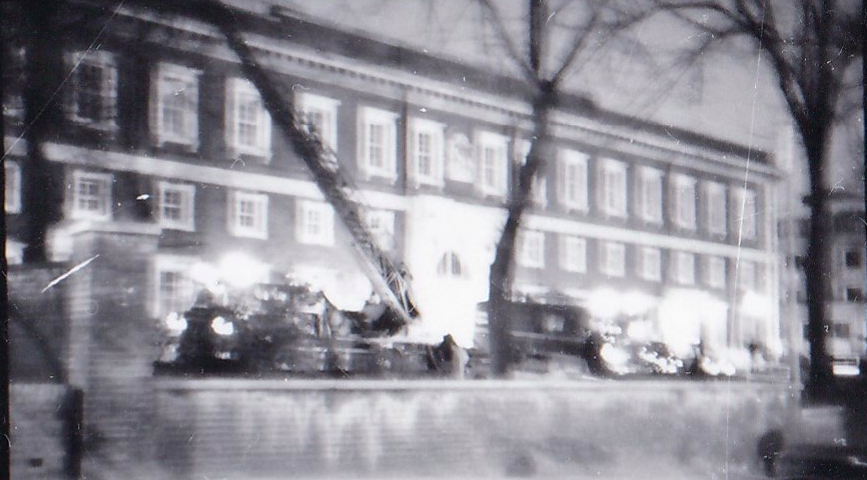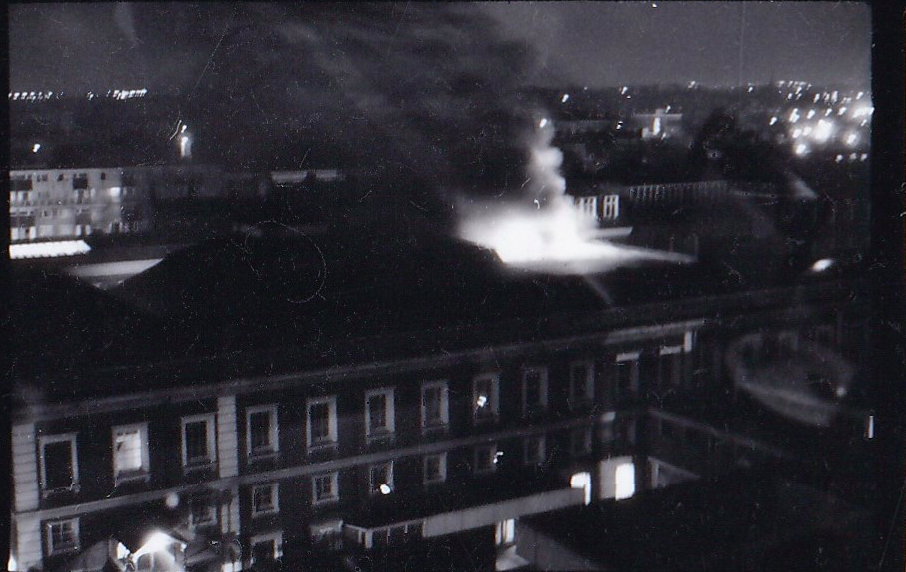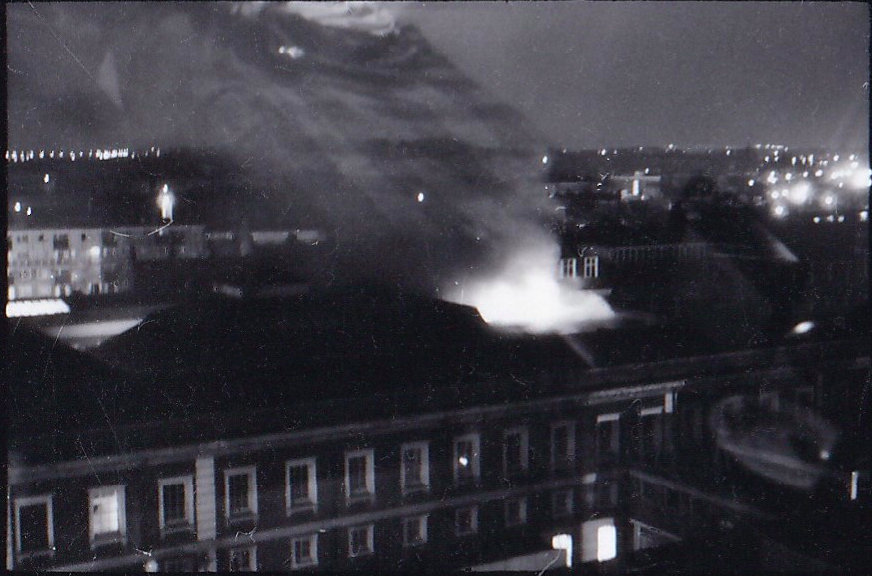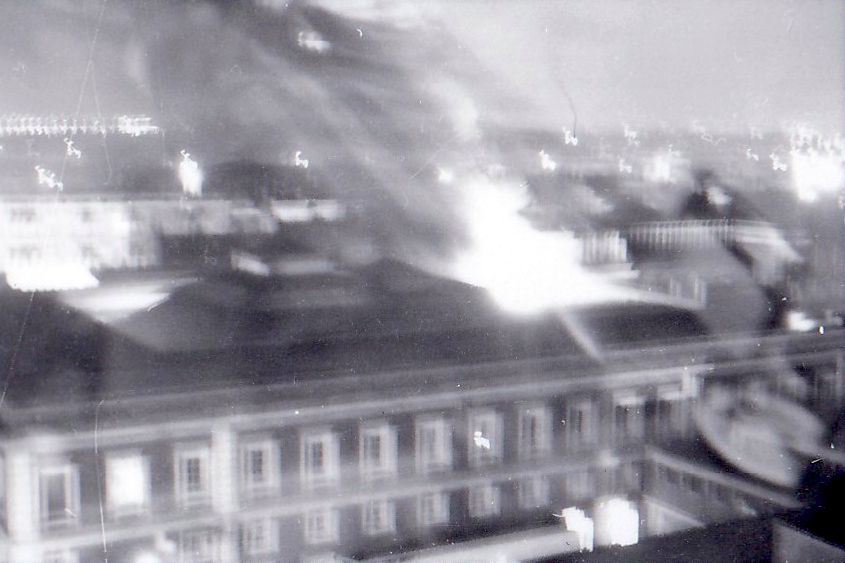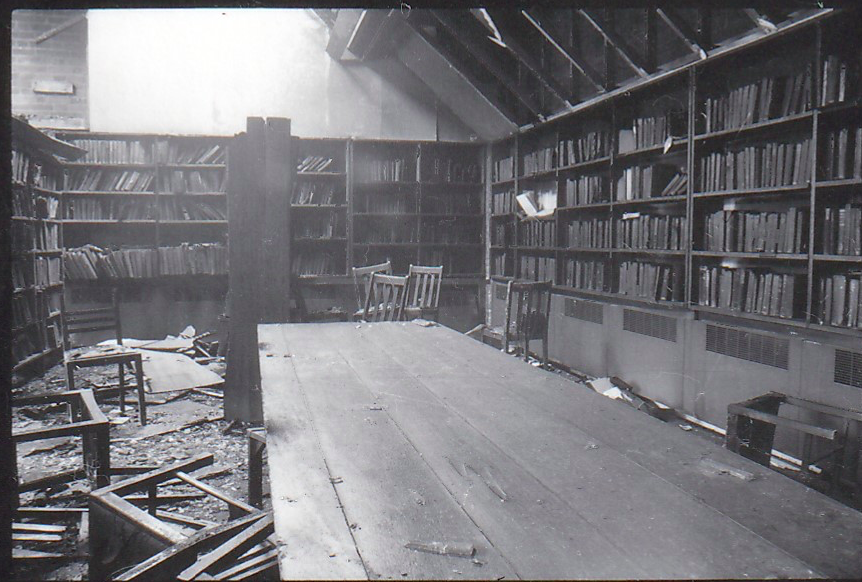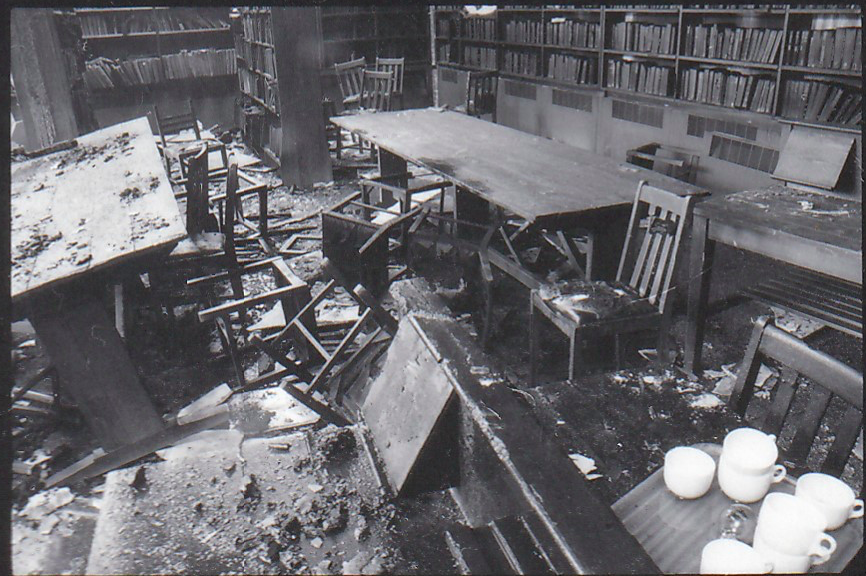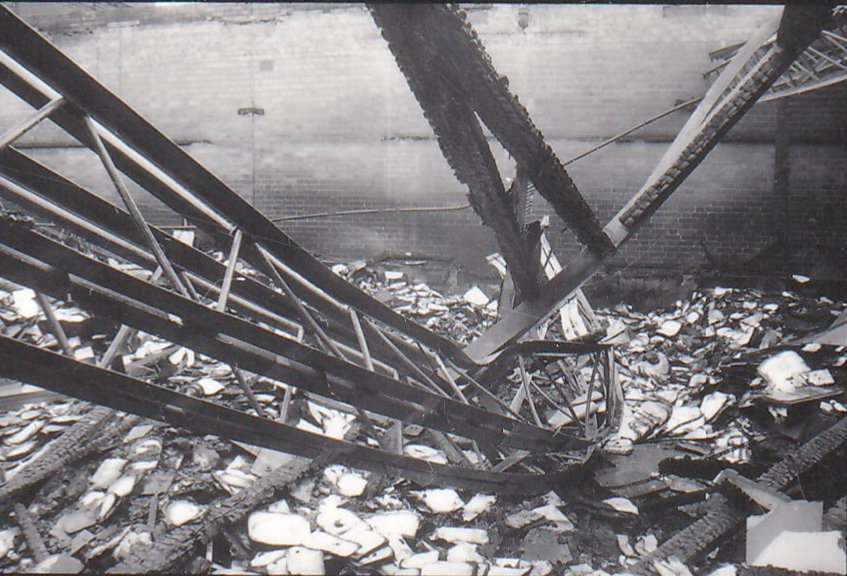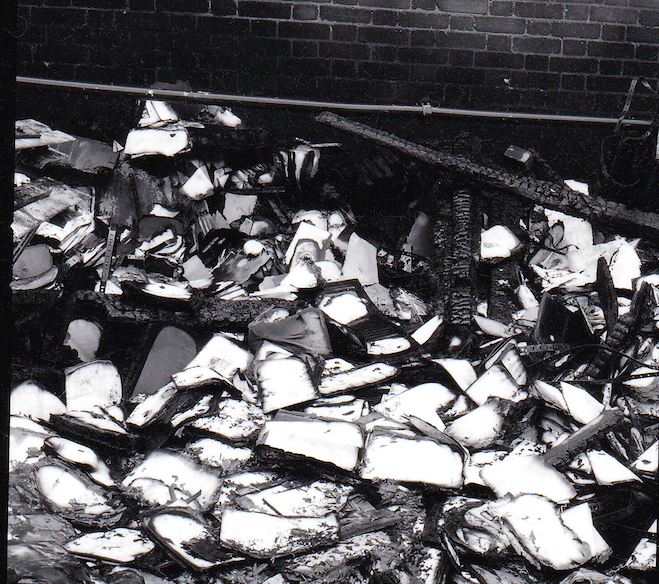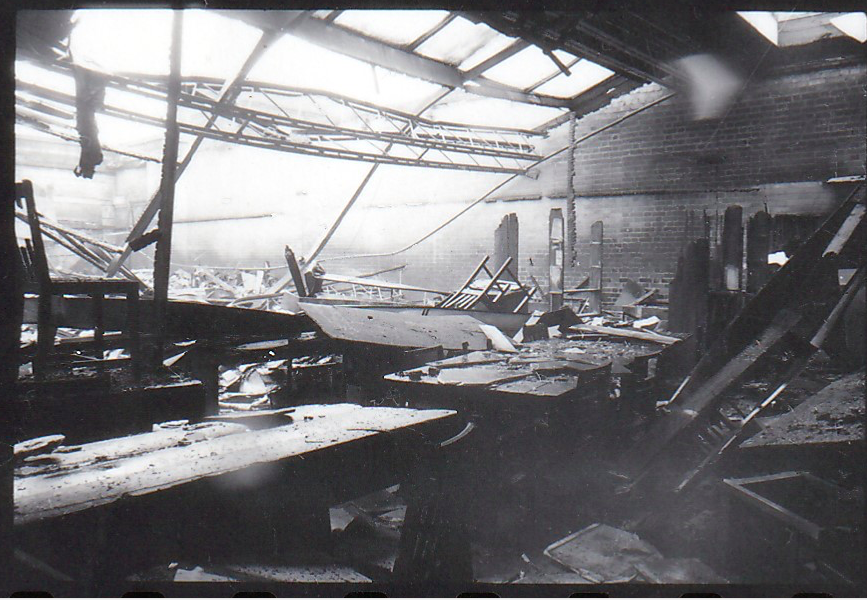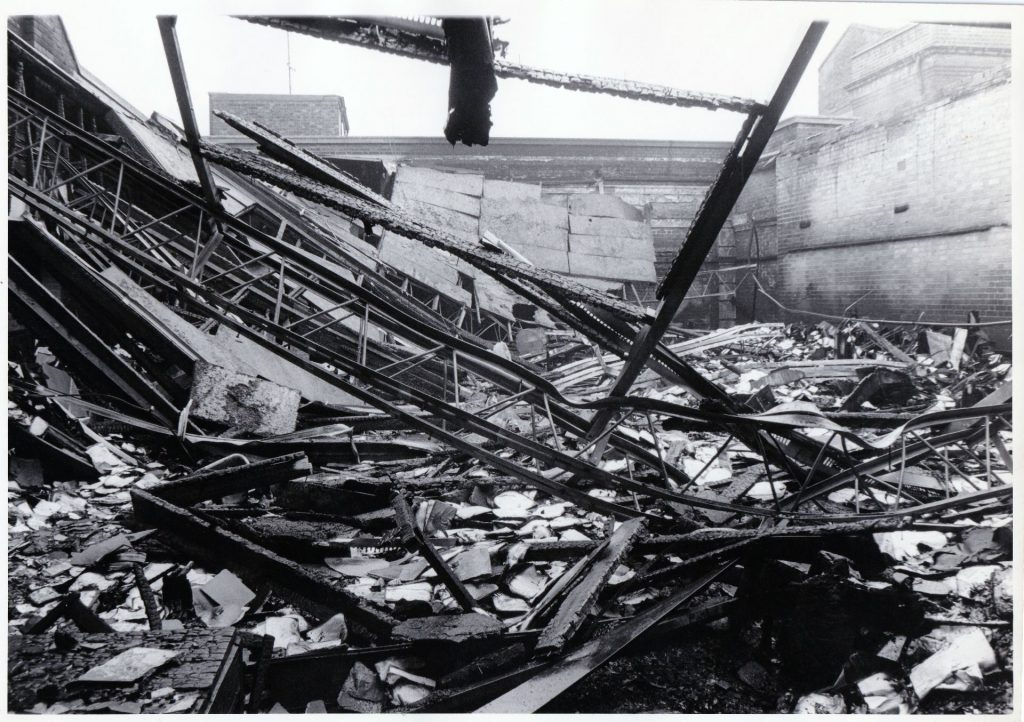
The destruction caused by the fire in Goldsmiths’ College library in March 1971. Image: Goldsmiths’ archives.
For three to four years between 1968 and 1971 Malcolm McLaren, then known as Malcolm Edwards, was a charismatic, enigmatic, disruptive and strikingly original art student activist at Goldsmiths’ College.
It seems likely his behaviour as a Situationist Marxist was being regularly reported to Metropolitan Police Special Branch and then on to MI5.
He helped instigate the biggest, loudest and most memorable art and music festival in the university’s history.
It’s never been repeated because when King Crimson played the back field, they could be heard loudly and clearly in Hilly Fields Park near Ladywell- well over a mile away.
So many thousands descended on the College grounds- lured there with the exaggerated and false promise of Pink Floyd and the Rolling Stones, College security and the police surrendered all hope of controlling the numbers.
The scent of marijuana was in the air and lying and rolling around on the grass in the summer sunshine, it could be said people got to know each other much more intimately than would normally be expected in an educational environment.
Malcolm left Goldsmiths without completing his degree, spooked the senior management of the College by invading and squatting in their meetings with ‘silent staring’, stole the library’s most expensive art books to sell to Charing Cross Road rare book dealers and later confessed to burning down the College library to cover his traces.
It’s also been claimed he assaulted Andrew Forge, the chair of the Art School’s Academic Committee with a copy of Chairman Mao’s ‘Little Red Book,’ and the agitation and student unrest he fomented generated intolerable stress for the Art School’s Principal.
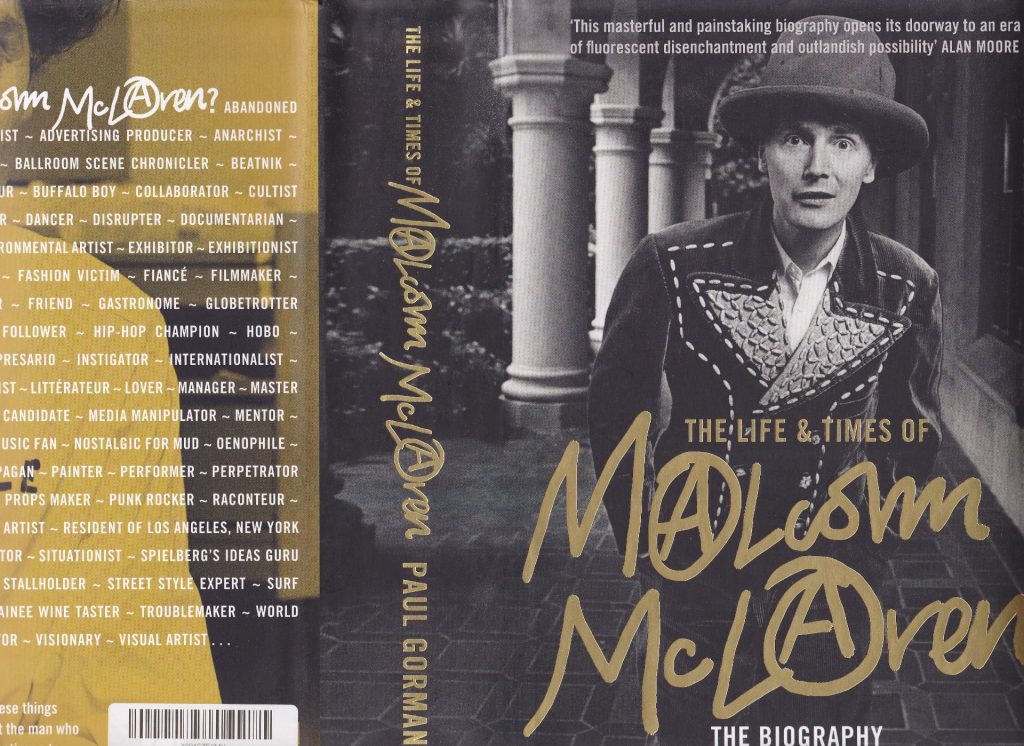
Cover of the much-acclaimed biography of Malcolm McLaren by Paul Gorman, published by Constable in 2020
In 2020 the back cover of his acclaimed biography by Paul Gorman offered some 86 descriptions and identities to attempt to answer the question ‘Who was Malcolm McLaren?’
Many of his contemporaries and alumni interviewed for the Goldsmiths’ History project would agree with ‘troublemaker, anarchist, exhibitionist, media manipulator, and Situationist.’
Those sympathetic to his complex and creative personality would also agree with ‘cultist, art student, enabler, friend, iconoclast, humorist, performer, painter, raconteur, romantic, visual artist and visionary.’
In popular culture, the Guardian said Malcolm McLaren was ‘the Manager of the Sex Pistols and a pivotal influence on late 20th-century pop culture.’
Dave Simpson wrote that the impresario ‘was one of the pivotal, yet most divisive influences on the styles and sounds of late 20th-century popular culture.’
He is perhaps best known as manager of the Sex Pistols, the punk-rock band that was a rude and loud cultural counter-point to the Queen’s silver jubilee in 1977. When he died in 2010, the BBC reminded us that ‘he was arrested on the Queen’s Silver Jubilee after sailing down the Thames on a boat with the band while they played their anti-establishment song God Save The Queen.’
The lyrics continued: ‘The fascist regime, They made you a moron, A potential H bomb’ when sailing by the Palace of Westminster.
Simpson said: ‘With his first partner, the designer [now Dame] Vivienne Westwood, he popularised looks from punk to fetish, which still dominate the fashion world.’
The journalist Julie Burchill once said ‘we are all children of Thatcher and McLaren.’
Paul Gorman explains in the introduction to The Life and Times of Malcolm McLaren ‘he was not interested in operating on the fringes.’
He was ‘an enthusiastic internationalist intent on fast-tracking vanguard ideas to the heart of the world’s mass media and entertainment industries, engaging along the way with major record companies, film studios, national broadcasters, the fashion trade and global ad agencies, and popping up in the public glare, whether at an Art Basel preview, a Beijing recording studio, on the front row of a Paris haute couture catwalk extravaganza or in a high-ratings British reality TV show. ‘
Malcolm Edwards/McLaren publicly confessed to the Goldsmiths’ College library fire in the first issue of the stylish and iconic magazine Fantastic Man in 2005 edited by Jop van Bennekom and Gert Jonkers.
No doubt he would be delighted to know that copies of this issue of the fashion magazine are so much sought after, they each sell for around $1,000.
He said he caused the fire with two unnamed college friends because the college authorities had called in the police to investigate his stealing of expensive art books from the library.
He said: ‘I was so concerned. They were getting close to nabbing me…And like lunatics we decided the best thing to do is to burn the library down so there would be no finger-prints. We thought…let’s burn it down. And that’s what we did. We burnt down the Goldsmiths’ College library.’
Paul Gorman reports in the biography that McLaren ‘delighted in telling Goldsmiths alums, including the British artist Damien Hirst, who observed that McLaren had likely impaired his education at the institution in the 1980s as a result.’
Goldsmiths’ Special Collections has contact prints of the dramatic and extraordinary roll of film taken of the fire in the early hours of Saturday morning March 13th 1971, the response of the police and the London Fire Brigade, and the terrible destruction to the library’s most treasured books and archived documents.
The remarkable and in some places disturbing black and white images are shown here for the first time. They are heart-breaking for anyone who loves books and cherishes and understands the cultural value of libraries in education and human society.
- The charred destruction of books still on their shelves and furniture in the library fire of 1971.
- One eighth of the roof of the main building was destroyed. Fire, smoke and water damage affected all floors. Images: Goldsmiths Archives
If McLaren was telling the truth, he and his friends stole and destroyed irreplaceable treasures and memories of Art and Drama and the history of Goldsmiths and its staff and students.
The damage in 1971 was estimated at around £150,000.
With inflation that would be one and a half million pounds in today’s money (28th September 2021).
The History Project has gained access to the London Fire Brigade official report of the fire, and also established the somewhat perplexing perspective that the Metropolitan Police say they have no records of any criminal investigation.
However, the Metropolitan Police have also tenaciously resisted Freedom of Information requests for access to Special Branch files on the activities of Goldsmiths staff and students during this period and these would inevitably have included him.
It is more than likely Special Branch monitored and kept a file on Malcolm McLaren. Goldsmiths’ College was in regular liaison with the Branch on subversive and disruptive political activities by staff and students.
The reporting and contact had been established from the time of the Cold War and Goldsmiths was effectively the home for the annual congresses of the London District of the Communist Party of Great Britain.
While the Fire Brigade report says the supposed cause of the fire was ‘unknown’, it is now clear that the Warden of Goldsmiths at the time, Sir Ross Chesterman, his Registrar, George Wood, and their head of security, Len Lusted were convinced the fire was deliberately started and spoke quite openly about it to journalists, colleagues and students.
Sir Ross wrote a rather controversial ‘story of Goldsmiths’ College 1953-1974′ covering his time there as Warden.
Golden Sunrise was privately published in 1996, nine years before McLaren’s confession in Fantastic Man.

1966 edition of Quotations from Chairman Mao Tse-Tung- allegedly used by Malcom McLaren to assault a senior member of staff at Goldsmiths’ Art School. CC BY-SA 4.0
Sir Ross provides a detailed account of the troubles caused by students he believed had been inspired by Mao Zedong’s Chinese Cultural Revolution though in those days the Chinese Communist Party leader’s name had been romanized as ‘Mao Tse-tung’.
It is likely Chesterman was referring to McLaren and his friends, though he does not accuse anyone in particular of being the library arsonist.
In fact, he makes no mention of the Library fire at all in Golden Sunrise.
Chesterman wrote about a painting group of ‘about a dozen strong, and included a number of almost illiterate students, men and women, all of whom seemed to have a serious chip on their shoulders. One of the women students was a dwarf – a real dwarf of the kind one sees in circuses. I had nothing, of course, against her physical condition, but she also was one of the leading troublemakers…the group would spend the day sitting in a studio and arguing about social conditions in Britain. After some time they became bolder, and undertook what I found a disquieting and even frightening course of action.
They would come up to my room, unannounced and uninvited, and sit down wherever there was a seat. They would say nothing and just keep there for about twenty minutes. Then, suddenly, they would all get up and walk out. I was not the only target – they would use the same treatment on other senior members of staff. Perhaps the worst aspect of this kind of silent invasion is that they would arrive late in the afternoon, when one was tired after a day’s work, and when the College was almost empty, so that no help was at hand if they were to turn violent.’
Chesterman’s language and attitudes betray the chasm in generational distance as well as the disparaging, patronising and offensive language and description which Malcolm’s friend and fellow art student Helen Mininberg, later known as Helen Wellington-Lloyd, had to contend with.
Helen continued her friendship and artistic collaboration with McLaren after Goldsmiths, designing typography and posters for the Sex Pistols and appearing in Derek Jarman’s film Jubilee in 1977 and The Great Rock ‘n’ Roll Swindle, by Julien Temple in 1980.
In 2001, the BBC reported on the sale of her collection of Sex Pistols’ memorabilia at Sothebys.
She was described as ‘a close friend and confidante of Malcolm McLaren, having met him at Goldsmiths School of Art in 1968’ and said: ‘We became friends immediately, probably because we saw ourselves as misfits in society.’
Gorman’s 2020 biography provides valuable insights into Malcolm’s time at Goldsmiths.
This includes an interview with his personal tutor and art lecturer, Barry Martin, who offers a sympathetic account of the tolerant mentoring and guidance provided by some staff much closer in age to Malcolm and his students than the College and Art School hierarchy.
They were in tune with the tectonic transformations of figurative to conceptual art, the representational being challenged and transformed by political, abstract and revolutionary ideas. They had been students when campuses revolted against the Vietnam War, global capitalism and much else.
Chesterman was a scientist and belonged to a generation which had little or no understanding of youth culture aesthetics:
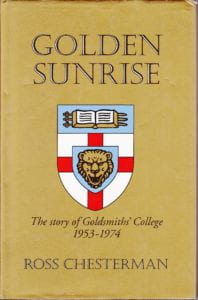
Sir Ross Chesterman’s memoirs of his time as Warden of Goldsmiths’ College 1953-1974. Image: Goldsmiths Archives
‘…students in the first and second year painting course joined in the programme of aggression, one student producing a selection of pictures which one might well have been entitled “Nazi Memorabilia’. I was greatly helped in resolving this particular incident by one of the college porters; he came to see me one afternoon after the day’s painting was over and, in some embarrassment, told me that the sight of large German swastikas made him feel very angry indeed, particularly, he said, when he remembered what he had had to put up with during his four years of fighting. “So, if you don’t object, Warden,” he said to me, “I would like to remove the pictures and destroy them.”‘ And that is what he did.
In contrast, Art lecturer Barry Martin was able to understand the context and motivation of McLaren and his friends. He told Paul Gorman: ‘He was argumentative…He liked trouble and causing a disturbance, constantly questioning what we were doing. I think he saw himself as a Che Guevara figure, rousing the troops to storm the barricade.’
Gorman writes: ‘Arriving early one morning Martin found McLaren laying out chicken wire across the Goldsmiths’ hut floor and unsuccessfully trying to hook it up directly to the mains. McLaren told Martin that, once electrified, his idea was to encourage a chicken to walk across the wire, a variation of the music hall routine of making hens dance on biscuit tins by placing lit candles inside them. Pointing out that this was extremely dangerous for McLaren, let alone the chicken, Martin persuaded the student to abandon the plan and saved him from electrocuting himself.’
Gorman has published images online of some of the paintings McLaren did at Goldsmiths in 1969 while being taught by Barry Martin. The paintings went on show for the first time in 2014-15 at Le Magasin, Site Bouchayer-Viallet in Grenoble.
Gorman said: ‘During a 90-minute critical review by his teacher Barry Martin, Edwards (soon to revert to his birth-name of McLaren) declared his rejection of the limitations imposed by traditional art forms, in particular painting. McLaren subsequently destroyed all but one of the works. In a symbolic statement the exception, the largest canvas – the 7ft tall Map Of British Isles With Yellow Star And Hole, into which he had already kicked a sizeable hole – was left to rot in the summer rain in the yard at the back of the college. Eventually it was torn apart and taken away by the dustbin-men.’
Online and in the biography, Gorman explained that ‘McLaren dedicated his remaining two years at Goldsmiths to organization of events and film-making, one about his hero, the early British rock’n’roller Billy Fury merged into an unfinished commentary on consumerism centred on the history of London’s main commercial thoroughfare, Oxford Street.’
- Police and London Fire Brigade appliances arrive at the front of Goldsmiths’ College just afer 2 a.m. on 13th March 1971. We do not know who was responsible for taking the roll of film images preserved as contact prints currently in the College’s Special Collections. It could have been a firefighter or member of College security.
- Many of the pictures taken in the middle of the night are blurred because of the limited light. This adds to the drama. As fire engines arrive, some students are seen standing on the College’s outer front wall. Others realise they need to remove their parked cars. There had been a student union concert at Goldsmiths on the Friday night. Images: Goldsmiths Archives.
It was six minutes past 2 a.m. on Saturday morning 13th March 1971 when the London Fire Brigade received a telephone call of a fire in Goldsmiths’ College main building. It had been discovered by a student two minutes before having started somewhere in the middle of the library on the second floor.
Student teacher at the time, James ‘Bert’ Bremner, lived up on the eighth floor of Warmington Tower which was then a student hall of residence.
He recalled ‘Sometime one of the people who lived on the college side told us the college was on fire. I think we had just got back from an event at the college. It might still have been continuing. So we looked, realised it was the library, contacted the porters, and told them, Maybe we even 999’d it ourselves.’
The weather was dry and clear and so were the road conditions when fire engines left New Cross fire station and arrived outside the college only three minutes later.
It is certainly the case that had Warmington Tower not been built next to the main building only a few year before, the fire would not have been visible from the ground for some time, and only fully noticed after a much more damaging spread and escalation.
When the appliances pulled up, the fire was quickly spreading to the roof largely because much of the substance used for its construction comprised of boards of compressed straw- a cost effective building material needed to repair the main college building cheaply and quickly after Luftwaffe destruction during the Second World War.
Yes, incendiary bombs at the end of December 1940 had indeed burned down the College’s library then. Many books had been taken to Nottingham University with staff and students leaving New Cross in the autumn of 1939, but thousands remained and 12,000 were destroyed by flames and water.
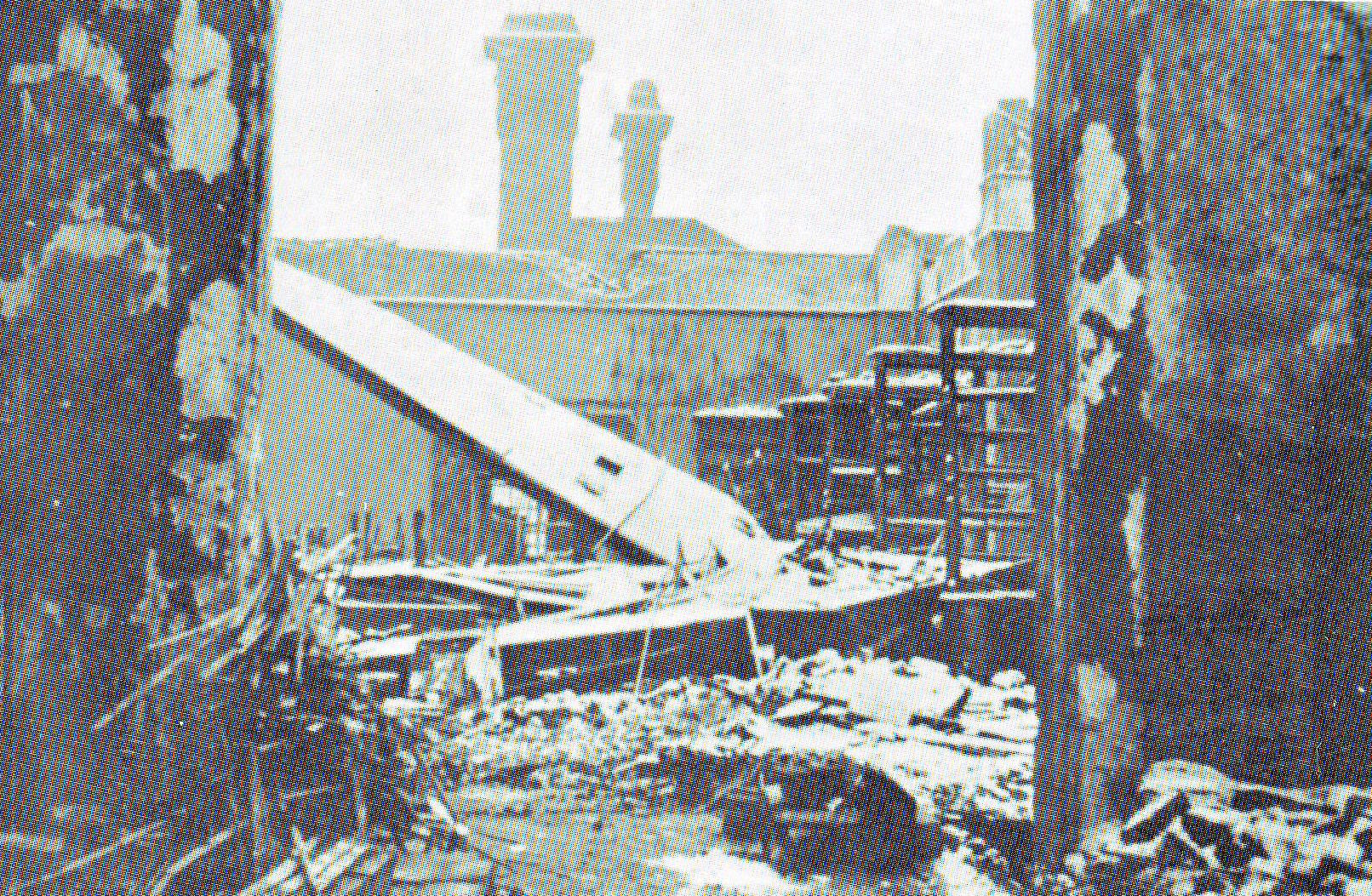
The College library suffered catastrophic damage on 29th December 1940 when incendiary bombs rained down from Luftwaffe planes during the Blitz of the Second World War. This photograph shows the roof has gone and there are skeletons of library bookshelves. Image: Goldsmiths Archives.
They had been piled up into a huge mound in the middle of the Great Hall and remained there for much of the Second World War period as some kind of detritus monument to the Blitz.
- Here are views and perspectives from Dixon Road. First very distinctive Metropolitan Police Morris Minor ‘Panda’ cars. The photographs show a heavy presence of both uniformed and CID police officer vehicles.
- The silhouette of a Fire Engine parked on the pavement in Dixon Road. The London Fire Brigade report discloses that thirteen appliances were needed. The photographs show that they used at least one high turntable ladder to gain access to the roof.
- Four ‘pump’ appliances were needed to provide jet stream power for water extracted from hydrants. A ‘London salvage Corps Tender’ was also sent to the scene.
- A view of Dixon Road practically blocked with emergency vehicles looking from the corner bending round from Laurie Grove. Images: Goldsmiths Archives.
Dave Riddle had been Student Union social secretary at Goldsmiths the year before the fire and is a another compelling witness to the events of that morning:
‘Another fellow alumnus (Neil Brittain) and I were employed at the time by the Goldsmiths Youth Club to run their discotheque every Friday in Brockley (where one of the evangelical churches now is just on the Goldsmiths side of the double roundabouts). There was a 9pm-2am event in the Great Hall on that night Friday March 12th going into the Saturday morning March 13th with Jon Hiseman’s Colosseum, Gary Wright Extraction and Universe. At it was due to finish at 2 a.m., the unexpected termination just before then did not cause too many issues compared to if it had been in the middle of a much longer event. We had ‘promoted’ the event at the Youth Club, although the line-ups were not really the sort of bands favoured by the youngsters of the Club at the time. Some did come down to the College, but I drove down with Neil as I had a car full of disco gear at around 11.30pm.
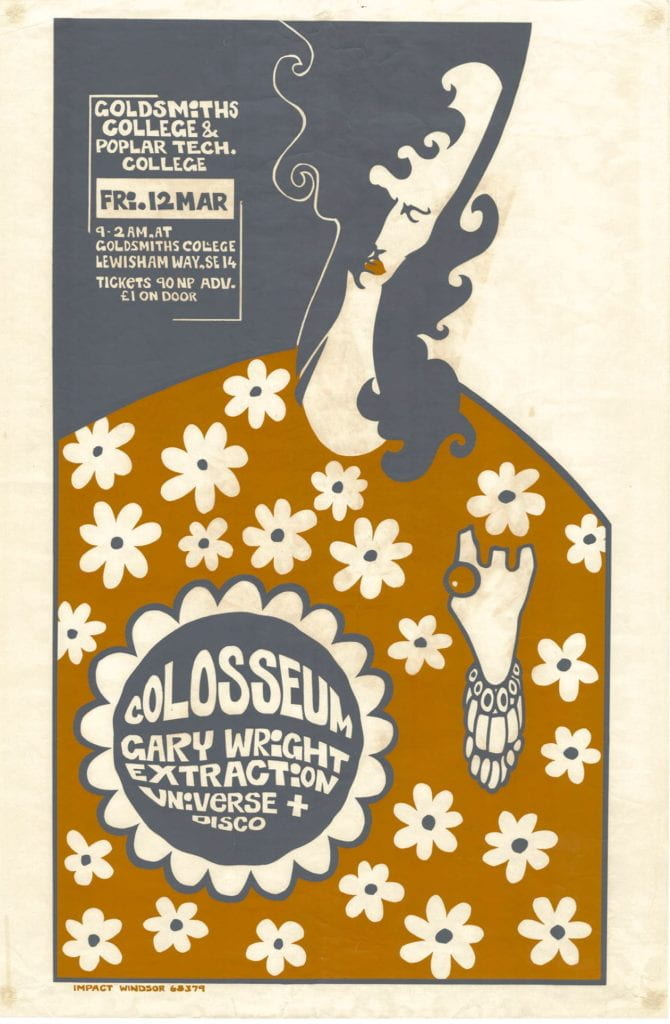
The poster for the Goldsmiths’ College and Poplar Technical College concert in the Great Hall Friday 12th and Saturday 13th March 1971- the night of the notorious library fire. With kind permission of Dave Riddle. All rights reserved.
After watching Colosseum play for an hour or so, at about 1.45 a.m. as far as I recall, the fire alarm went off which we thought was someone messing with one of the alarm buttons. We left the building via the side door by Security and out of the front of the College only to see smoke and sparks blowing out of the College roof in the direction of Lewisham Way. Two fire engines then arrived and the fireman strolled nonchalantly past saying ‘Well where’s the fire then?’ As if it wasn’t patently obvious! We were then efficiently herded in the direction of the Education Building courtyard and watched further events from there. Lots more sparks, flames and sparks.. but we were tired and since my car was parked almost exactly where we were, and potentially extracting it could have become difficult, we left at that point (around 2.30 a.m.).’
- This sequence of images shows the drama unfolding at the front of the main building. Any cars occupying the front car park have been removed. Pump appliances are connecting hoses to water hydrants.
- Firefighters seen moving quickly to unroll water hosing and fix them to a hydrant located close to the wall fronting Lewisham Way.
- With the fire quickly spreading across the roof, firefighters deploy a long turntable ladder so that they can direct water into the seat of the fire as well as prevent it spreading.
- Action pictures of the turntable ladder moving across the front of the main building. The Fire Brigade’s report said water from five jets, from three pumps, working from three statutory hydrants were needed.
- The strength and brightness of the fire taking hold on the roof the building can be seen here. The Fire Brigade needed one and a half hours to gain control of the blaze. They remained on site, including what is known as ‘a damping down’ process until 1 p.m. the following day. Images: Goldsmiths Archives.
James ‘Bert’ Bremner took up the story after alerting the porters and fire brigade from the eighth floor of nearby Warmington Tower.
He remembered: ‘Nothing seemed to happen so we popped down to the college entrance and were surprised there was no fire alarm – with people just strolling to and fro along the corridor to the bar etc.
Then the fire brigade arrived and asked where was the fire, and it seemed I was the only one who knew, so I took them along and up to the library doors which were locked. I asked if I could kick the doors in and was allowed to – but they did check to see if it was safe to do – and so I did – great fun.
We must have watched what was happening.’
‘Bert’ Bremner was a student teacher between 1969 and 1972 and modestly observed: ‘I was lucky to end up a Primary Teacher after that!’
The London firefighters were battling a fire which was threatening to engulf the entire building, which would certainly have happened had they not stopped it spreading across what was a tinder dry and flammable roof 150 feet by 350 feet.
Somewhere and somehow the photographer gained a vantage point which is difficult to identify. These were the days before drones. No Metropolitan Police or London Fire Brigade helicopter was available for deployment at this time. Was there some high point on the roof of Goldsmiths? Or had the LFB deployed another turntable high ladder with radio communication to coordinate the firefighting?
These images of the glow of the conflagration show the success and achievements of the operation by 3.33 a.m. Absolute fire destruction consumed one eighth of the roof and second floor and no more.
- This fascinating series of images shows the red hot glare of the fire taking root in the roof of the Goldsmiths main building.
- This picture gives some idea of the thick smoke gorging out from the roof boards, timbers, wooden furniture and incinerating valuable library books collected since the days of the Goldsmiths Institute when the Art School began in 1891.
- Is it moonlight or a trick of the fire lighting up the smoke? Mystery remains on where and how these pictures were taken.
- This image is very blurred and brighter. It might have been taken at the height of the fire or simply a matter of over-exposure when taken by the camera used. All images copyright of Goldsmiths Archives.
Later on Saturday morning with the sunrise, the senior management of the College were able to fully understand just how devastating an event this was. Goldsmiths had only one library.
And it was now gone at a time in the academic year when students on all programmes were needing to revise for exams and research and complete the final dissertations and essays for their undergraduate and postgraduate courses.
The LFB report on destruction is exact and defining: ‘About one eighth of roof collapsed. 2nd floor about 500 ft of middle brick well distorted and cracked, 200 square feet of walls stripped of plaster board, structure otherwise undamaged. Whole contents of library severely damaged by fire, heat, smoke and water. First Floor- about one eighth of floor and contents damaged by water. Ground Floor about one eighth of floor and contents damaged by water.’
In the daylight the fire event photographer roamed over collapsed and buckled roof girders and beams, charred and incinerated books, furniture and equipment. Everything had been blackened and soaked. Ash, cinder and dust and the acrid stench of burning and smouldering and shafts of sunlight streaming from a roof now open to the sky.
- On 27th March 1971 Sir Ross Chesterman told the Times the fire destroyed £100,000 worth of books. Nearly 25,000 books and periodicals had been lost.
- One of the casualties of the blaze was the total destruction of a new reading room that had been built to serve a College that at the turn of the 60s/70s decade now had 1,000 students.
- Shattered and buckled roof beams collapsed onto piles of destroyed books. Fortunately, the structure of the main library and 75 per cent of the total bookstock had survived.
- Sir Ross Chesterman wrote a letter to the Times Literary Supplement to explain that after the fire nothing survived of the library’s history collection. The collections on geography, basic sciences, mathematics, physical education, and theatre had been destroyed. Sadly in later years the teaching of four of those subjects would be closed.
- Sir Ross also said ‘Another particularly severe loss is that of all the fine art books serving the School of Art.’ Images: Goldsmiths Archives.
Sir Ross Chesterman wrote to the Times Literary Supplement on 2nd April 1971 effectively begging for donations of books. He said: ‘The College feels this loss even more keenly because this is the second occasion on which the library has suffered by fire. During the Second World War the main library and its bookstock were very severely damaged by enemy action.’
He explained that insurance could not cover all the costs needed to replace what was lost. The public appeal asked for ‘anyone willing and able to help by gifts of books or money to get in touch with the College registrar or librarian.
What is also clear from the media reports is that the College, police and fire brigade were investigating arson. Sir Ross told the Times ‘It could have been deliberate. I find it difficult to understand how an intense and localized fire could start accidentally.’ As he was a scientist, he knew that books did not just burn spontaneously: ‘I do know the exact meaning of the word “gutted”, but these were gutted.’
Dave Riddle was also aware at the time that arson had been suspected with a pretty forensic idea of how the fire had been set:
‘There were supposedly ‘hot-spots’ found in waste paper baskets thought to have been caused by ignited magnesium ribbon. The College Security head at the time, Len Lusted, was a good mate as I had been SU Social Secretary the previous year. He actually questioned Neil and me about whether any of the Youth Club kids may have been involved, but we had no knowledge of whether any of them were actually able to buy tickets on the door.’
Clearly there had been arson investigations, but it is a mystery why their reports have not survived in either Metropolitan Police or London Fire Brigade archives.
The Goldsmiths History Project has been pursuing Freedom of Information Act challenges to gain access to Malcolm McLaren’s Special Branch and MI5 files and those of others, and at the time of writing there is still an outstanding appeal to the Upper Tribunal Information Rights with the possibility of judicial review to the High Court.
In 2005, Goldsmiths and the authorities had a confession and motive from Malcolm McLaren as a prime suspect. But 34 years after the event, its publication in a somewhat esoteric fashion magazine became the source of rumour more than a sensational revelation catching the attention of mainstream media coverage.
Paul Gorman quite rightly speculates there is ‘a chance that the arsonist was someone else, and that, at a safe distance, McLaren laid claim to amplify his image as a dangerous subversive.’
The librarians who came to work on Monday morning 15th March 1971 to find that their professional world had been devastated by a roar of flame and destruction would recall the sad emotional impact of that experience and the struggle to rescue, repair and rebuild.
Whether the claim to be the library arsonist was bravado or truth, there was certainly a lack of emotional insight and understanding of the cultural offence of burning books.
This is particularly so from somebody with the same heritage as the German Jewish poet Heinrich Heine who poignantly said in his 1821 play Almansor ‘Dort, wo man Bücher verbrennt, verbrennt man auch am Ende Menschen.’ (‘Where they burn books, they will, in the end, burn human beings too.’).
Goldsmiths’ College knew all about Malcolm McLaren when they admitted him as an undergraduate. The art lecturer Peter Creswell knew about his ‘unusually aggressive and confrontational’ personality because he had taught him at Croydon College of Art when he gained his A Level in Art History.
For all his promiscuous attendance of several art schools at the same time, Malcolm did choose to commit to Goldsmiths in terms of three years of studying for an art degree with a lot of creative and memorable activism to go with it.
Fellow alumni tend to be more affectionate and tolerant than disparaging in their memories of the maverick student in red hair and bottle green jackets. They would often find his disruptive Situationist interventions simply exasperating and quite sensibly best ignored.
He once stood on the metal staircase of the new College refectory throwing plastic cutlery and shouting ‘You’re all just a bunch of ****ing ****s.’ The students he was haranguing simply raised their eyebrows and carried on eating their steak and kidney pies, and bangers and mash.
Russell Profitt was the first Black President of a UK University Student Union at Goldsmiths while McLaren ran his own political agendas for what was then a separate student union body in the Art School.
He remembers McLaren’s activities as more of a burlesque contribution to student life:
‘The constant agenda item was always around the price and quality of food in the refectory. It was anything but Fortnum and Masons. I guess more people thought that the academic leadership of the College certainly enjoyed the best. They had a staff restaurant. It seemed as though they would be getting the best chomps, chops and fruit, and whatever was left would be meagerly shared out to the rest of the student body.
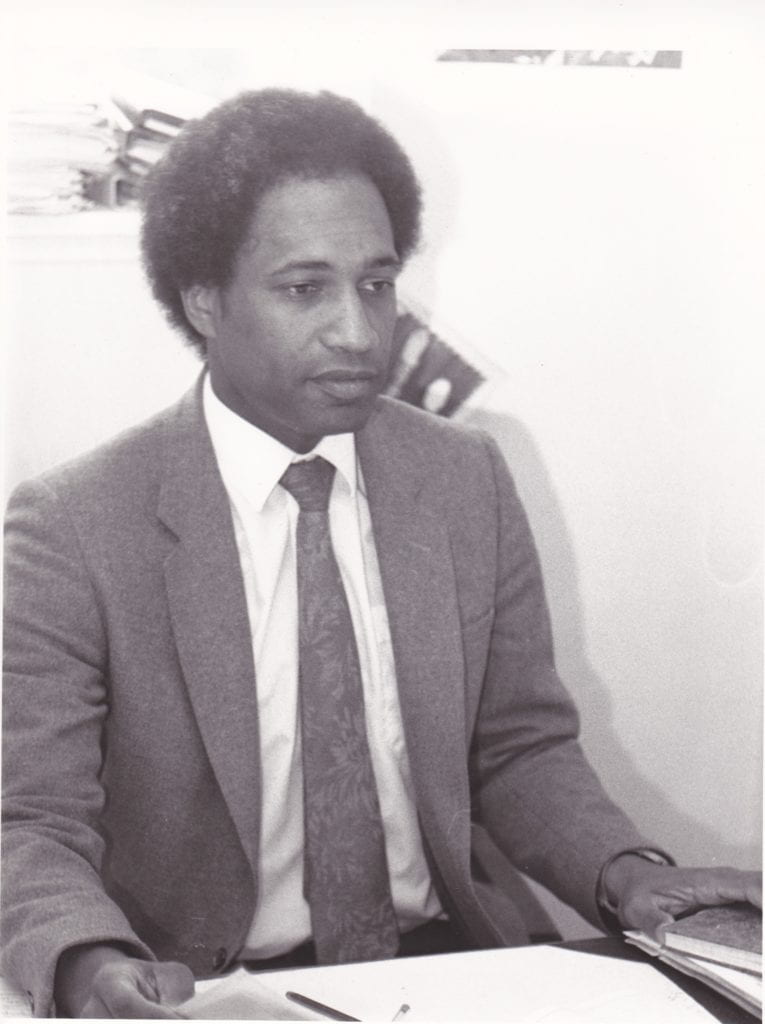
Russell Profitt MBE when President of Goldsmiths’ College Student Union during the late 1960s. He was the first Black President elected to any student union body in the United Kingdom. Image: Copyright Russell Profitt.
I remember holding a student union meeting in the Great Hall where food was on the agenda. The students would be sitting in chairs on the floor of the Great Hall looking very hungry. Myself and other Student Executives would be up on the stage together with Mrs Maureen Foley who was the first full-time secretary of the student union. She was indeed a legend and her friend Margaret Collier. They then helped to run the student union as they took notes and minutes and they made sure that whatever was said got recorded properly. They were on the platform with us.
Just as we were about to get into the debate on food, I noticed that the balconies left and right started to fill up with students. They were not students that usually attended general meetings. They were from the Art School. Malcolm Edwards, later Malcolm McLaren, was one of their leading lights and he was up there with his ginger hair flowing, wearing his lovely green coat and orange scarf.
As he sat there, I felt something was going to happen and looked up. Before I knew exactly what was happening, there was this enormous tirade of tomatoes heading down towards us onto the stage as a sign of protest. He was up there chucking his rotten tomatoes down saying “This is what I think of this place.” He was “effing and blinding” and this broke the whole meeting up because what landed on the floor was picked up by the students and thrown back up. There was this huge food fight in the Great Hall. The meeting ended in chaos.’
If Malcolm McLaren was a tortured soul at Goldsmiths, for all his complaining and disruption, he also seemed to be very happy. Another alumnus, Paul Thompson, remembered the ‘grin on his face having a great time…he often had a grin on his face in those days.’
Seven years after leaving Goldsmiths degree-less and with a trail of book stealing, arson, mayhem and creativity behind him, Malcolm McLaren became as famous and impactful as Mary Quant.
He was charming and charismatic when agreeing to do an interview in Soho in 1978 for myself and another journalism student from the London College of Printing. I operated the Uher tape recorder, and my fellow student asked the questions. The interview was so good it was bought by Capital Radio.
The history of Goldsmiths has a fascinating tradition of alumni who are creative and entertaining disruptors in art, politics, culture, fashion and academic thinking.
Malcolm Edwards McLaren certainly counts as one of the most remarkable, memorable and indeed infamous.
Forthcoming ‘That’s So Goldsmiths’- an investigative history of Goldsmiths, University of London by Professor Tim Crook.
Special thanks to Lesley Ruthven and Dr Alex Du Toit in Goldsmiths Special Collections, Andrew Lott, Senior Information Officer on behalf of London Metropolitan Archives, Dave Riddle, Russell Profitt and the many 1960s alumni who contributed background and information for this feature.
